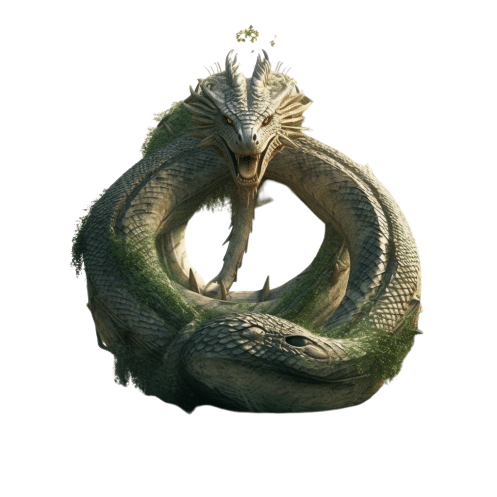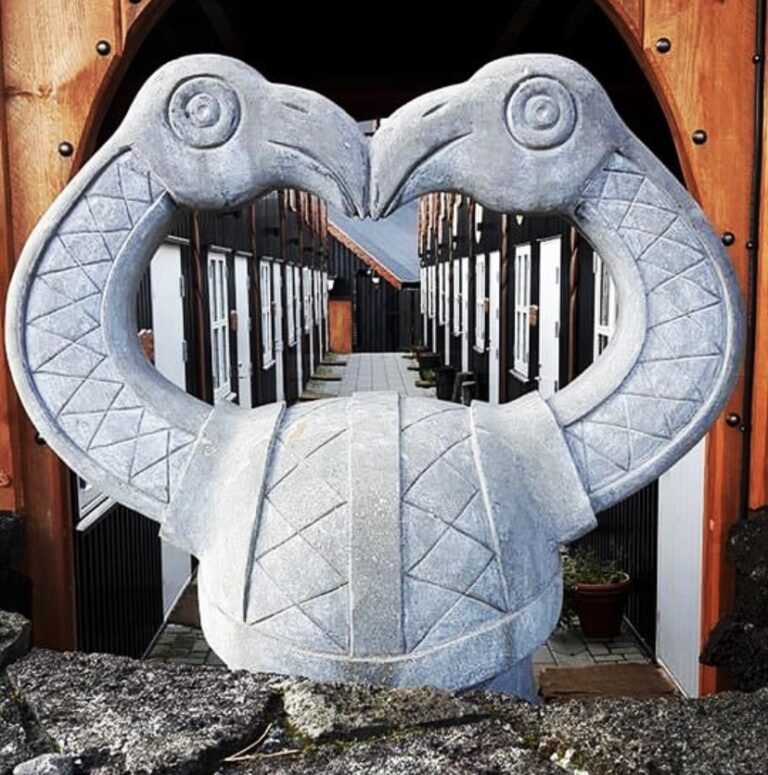World Serpents: Powerful Snakes from Mythology

In the captivating realm of Norse mythology, one creature reigns supreme: the serpent. Therefore, these creatures are often portrayed as both fearsome and awe-inspiring. They weave their way through the ancient sagas, leaving an indelible mark on the rich tapestry of Norse folklore. Furthermore, two important serpents are Jormungandr, and Nidhogg. The serpent Jormungandr encircles the world with its massive coils, and Nidhogg, gnaws at the roots of the World Tree. These two serpents hold a pivotal role in the cosmology and symbolism of the Norse pantheon. Come along as we unravel these magnificent creatures’ significance and enduring legacy.
As expected, world serpents have been a part of mythology and folklore for centuries. These world serpents, often depicted as powerful and fearsome creatures, have been a common theme in stories worldwide. From Norse mythology to Chinese folklore, world serpents have been present in many cultures. Naturally, each possesses their own unique characteristics and stories. With this in mind, this post will explore some of the most notable world serpents and their roles in mythology.
World Serpents in Norse Mythology
In Norse mythology, Jormungandr is a well recorded serpent who is an enemy to Thor, the god of thunder. According to the sagas, the two were destined to meet in battle during Ragnarok. Their encounter was said to be so violent that it would cause earthquakes and other natural disasters. However, Jormungandr was not always seen as an evil being. In some legends, he was depicted as a protector of the ocean and sailors. His presence was said to keep the seas calm and prevent storms. This would be important to the Vikings who were a seafaring people. They often embarked on dangerous ocean voyages.
Offspring of the trickster God Loki
Additionally in Norse mythology, Jormungandr or Midgard Serpent was one of the most significant and well-known world serpents. Jormungandr was the offspring of the god Loki and the giantess Angrboda. According to the legend, Jormungandr was so big that he encircled the entire world. Lastly, he also held his tail in his mouth. This is a popular image you see in Norse art. Norse mythology describes Jormungandr as an ominous and dangerous creature. He was seen as the harbinger of the end of the world. His death was said to be a sign of Ragnarok, the Norse version of the apocalypse.
Nidhogg: Forever Gnawing at the Base of Yggdrasil

At the same time, Norse mythology also features Nidhogg, another world serpent. Nidhogg was said to live at the base of the World Tree, Yggdrasil. He was known for gnawing at its roots. Obviously, Nighogg, was therefore considered a symbol of decay and destruction. So, his actions were seen as a threat to the stability of the universe. In some legends, Nidhogg was also associated with the underworld and was believed to devour the corpses of the dead.
Other Cultures with Similar Myths
Below are a few more examples of world serpents who have dominated history.
Chinese Mythology

In the same manner, Chinese mythology shares a history of serpent lore. The world serpent is known as the Zhulong or the Torch Dragon. The Zhulong is depicted as a serpent with a fiery body and a dragon’s head. According to Chinese legend, the Zhulong was responsible for controlling the movement of the sun and moon. Its movements were said to determine the length of the day and night. Additionally, the Zhulong was also believed to have the power to control the weather. Therefore, its fiery body was said to be the source of the sun’s heat. As you can see there are similarities between this myth and those of the Vikings. Both attribute unknown causes, like weather events, to mythical beings.
In Chinese mythology, the Zhulong was often associated with the element of fire and was seen as a symbol of power and authority. The dragon’s head was said to represent the emperor, while the serpent’s body represented the people. The Zhulong was seen as a protector of the people, and its power was believed to bring prosperity and good fortune.
Greek Mythology

In Greek mythology, the world serpent was known as the Ophion. According to legend, the Ophion was the first creature to emerge from the primordial chaos at the beginning of time. In literature, the Ophion was a powerful and divine creature, and its movements were said to control the tides and the flow of the rivers. Again, this guy controls the weather.
The Ophion was often associated with the goddess Gaia, who was believed to have created the world. The Ophion was seen as a symbol of the primal forces of nature. It was associated with fertility, growth, and renewal. Despite its divine status, the Ophion was not always seen as benevolent. Therefore, the Ophion is often depicted as a trickster figure. It is said to change shape at will and manipulate the natural world to suit its own
This isn’t rare, as serpents are often associated with fertility, transformation, and renewal. Here are some of the most notable serpents in Greek mythology.
Python

In Greek mythology, Python was a giant serpent that lived in a cave near the Oracle of Delphi. According to legend, Apollo killed Python with his bow and arrow. He then took control of the Oracle of Delphi, which was previously guarded by the serpent. Python was believed to represent the forces of chaos and was seen as a symbol of the earth’s fertility. His death by Apollo symbolized the triumph of order over chaos and the birth of the sun god’s reign.
Medusa

Medusa is one of the most famous serpents in Greek mythology. She was a beautiful woman with snakes for hair, and anyone who looked at her turned to stone. According to legend, Medusa was originally a beautiful maiden, but she was cursed by Athena for being too proud of her beauty. The curse transformed her into a monster with serpents for hair and a gaze that could turn people to stone.
Eventually, Medusa was killed by the hero Perseus, who used a mirror to avoid looking directly at her. After her death, her head was mounted on Athena’s shield, and it was believed to have the power to petrify anyone who looked at it.
The Caduceus
The Caduceus is a symbol often associated with medicine and healing. It features two serpents intertwined around a staff with wings on top. In Greek mythology, the Caduceus was the staff carried by Hermes, the messenger god. The serpents on the Caduceus were believed to represent the duality of life. This included life and death, good and evil, and health and illness. Therefore, the Caduceus was also believed to have healing properties and was used as a symbol of protection and good fortune.
The Hydra
Another serpent, the Hydra was a multi-headed serpent that lived in the swamps near Lerna in Greece. According to legend, the Hydra was a formidable creature that could regenerate its heads if they were cut off. Heracles, the legendary Greek hero, was sent to kill the Hydra as one of his twelve labours. During the battle, Heracles realized that cutting off the Hydra’s heads only made it stronger. Eventually, he discovered that he could kill the Hydra by burning the neck stumps after cutting off its heads.
The Hydra was believed to represent the destructive forces of nature. Its defeat by Heracles symbolized the triumph of order over chaos.
Serpents have played a significant role in Greek mythology, representing a range of themes, including fertility, transformation, and destruction. These creatures have left an indelible mark on Greek mythology and continue to be celebrated and referenced in contemporary culture.
Conclusion
Accordingly, serpents have been recognized for their profound contributions. Norse mythology stands as a testament to the enduring power and symbolism of these magnificent creatures. Certainly, they have embodied chaos and destruction. But, they have also had roles as guardians and agents of destiny. Therefore, serpents have woven themselves deeply into the fabric of Norse culture and belief. Because of this, we gain insight into the ancient Norse worldview. We learn of their fears and aspirations, and the intricate interplay between gods and mortals. These serpents, with their formidable presence and timeless significance, remind us of the enduring legacy of Norse mythology. They also provide captivating mysteries. In conclusion, I hope the serpents of Norse mythology continue to captivate and inspire us. Without a doubt, their majestic tales will continue to be passed down through the ages. They will be forever entwined within the tapestry of our collective imagination.






